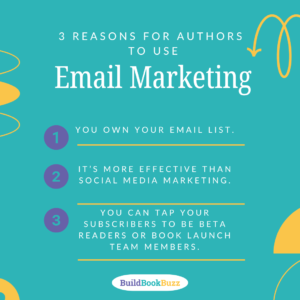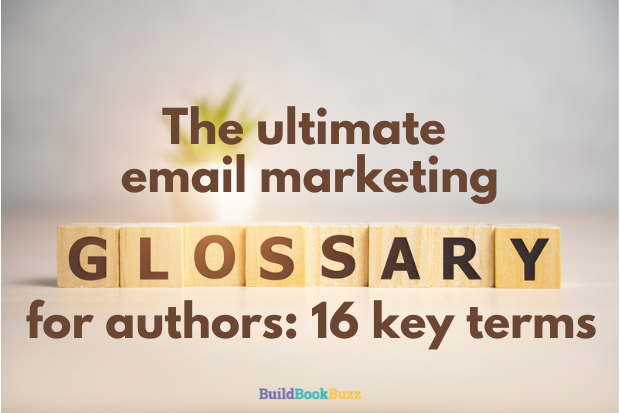The ultimate email marketing glossary for authors: 16 key terms
Not on board with email marketing yet? Don't let buzzwords hold you back. This email marketing glossary for authors will get you started.
Affiliate Disclosure: This post contains affiliate links, which means if you click on them and make a purchase, I will receive a small commission (at no extra charge to you).
When I spoke about “the one thing that will make a difference” at the Find Your Readers Summit last month, I focused on email marketing.
Here are just a few of the many reasons I believe authors should build an email list:
- You own your email list. You don’t own your connections on any social network, whether it’s Facebook, Instagram, LinkedIn, or the others. If one of them crashes, or if you get kicked off the site, you’ll lose your audience.
- It’s more effective than social media marketing. So why not put your time where it will pay off the most?
- You can tap your subscribers to be beta readers or book launch team members. Stop fishing for reader support on social networks. You’ll find them in your email subscribers.
If you want to sell books, you need to get on board with email marketing.
Why aren’t you using email marketing?
 So why aren’t more of you building an email list you can use to communicate regularly with the people who read the kinds of books you write?
So why aren’t more of you building an email list you can use to communicate regularly with the people who read the kinds of books you write?
The problem for many (you, maybe?) is that they don’t know where to begin.
When I’m tackling a new area, I often start by studying the terms used. If I don’t, I spend way too much time Googling and not enough following instructions. (That’s why I added publishing and marketing glossaries to this site for you.)
So let’s start there — with the terms commonly used when people discuss email marketing. When you understand them, you won’t feel like you need to use Google Translate when you begin researching email service providers.
The email marketing glossary for authors
To minimize overwhelm, I’ve limited the number of terms defined. So, while it isn’t a complete author email marketing glossary, it should be enough to reduce the intimidation factor.
Bounce rate: The percentage of emails that are not successfully delivered to recipients. Bounces can be classified as either hard (permanent delivery failure) or soft (temporary delivery failure).
Call to action (CTA): A prompt or button within an email that encourages recipients to take a specific action. That might be visiting a website or making a purchase.
CAN-SPAM: A set of rules and requirements established by the United States Federal Trade Commission (FTC) to regulate commercial email messages sent to recipients within the USA.
Click-through rate (CTR): The percentage of recipients who click on a link within an email compared to the total number of emails delivered.
Conversion rate: The percentage of recipients who take a desired action (such as making a purchase or filling out a form) after clicking on a link in an email.
Double opt-in: A process where subscribers confirm their email address and consent to receive emails by clicking on a verification link sent to their inbox. It provides an added layer of permission and reduces the risk of spam complaints.
Deliverability: The ability of an email to avoid the spam or junk folder and successfully reach the recipient’s inbox .
Email automation: The use of automated workflows or triggers to send emails based on certain actions or events (such as welcoming new subscribers as soon as they subscribe).
Email service provider: This is a software company that provides an email marketing platform or tool that connects to your website and lets you acquire names and email addresses and create and send bulk emails to those addresses (subscribers). It automates all of this for you.
Lead magnet: The digital, downloadable incentive you offer your target readers in exchange for providing their email address and adding themselves — “opting-in” — to your email list.
List hygiene: The process of regularly cleaning and updating email subscriber lists to remove inactive or invalid email addresses, reducing bounces and improving deliverability.
List segmentation: The process of categorizing email subscribers into different segments based on specific criteria (demographics, interests, purchase history, etc.). It allows for more targeted and personalized email campaigns.
Open rate: The percentage of recipients who open an email compared to the total number of emails delivered. It indicates how engaging the subject line and email content are.
Opt-in: The act of giving permission for a sender to email someone by willingly subscribing to a mailing list. Don’t risk being identified as a spammer by adding people to your email list. Invite them to add themselves using an opt-in process.
Personalization: The practice of tailoring email content and design to specific subscriber information. For example, personalization lets senders add the recipients name to the message subject line, salutation, or anywhere else in the message, among other things.
Unsubscribe rate: The percentage of recipients who choose to unsubscribe from a mailing list after receiving an email.
Authors, don't risk being identified as a spammer by adding people to your email list. Invite them to add themselves using an opt-in process.Click to tweetGetting over that next email marketing obstacle
Now that you’re more familiar with some of the terminology, you’ll want to start thinking about:
- The email service provider you contract with (I use ConvertKit; it’s designed for creators like us).
- The freebie or lead magnet you’ll offer readers in exchange for their name and email address (here are ideas for novelists and nonfiction authors).
- How often you’ll email your subscribers.
- What you’ll send them.
Get started by adding yourself to author and marketer lists so you can see how others handle email marketing.
Add yourself to author and marketer lists so you can see how others handle email marketing.Click to tweetStudy what they share in their emails and how the information is presented. Do they use text only or do they feature a combination of text and graphics? Which of these formats resonates with you?
Review the types of content they offer and how they do it. Some people send self-contained newsletters, while others (like me) provide only a portion of the text in the message and link to the rest online. Which approach do you prefer?
When you learn the terms above, then learn how you want to show up in your subscribers’ inboxes, you will begin to gain the confidence you want for the next step.
Do you offer an email newsletter? Please provide a signup link in the comments so other authors can subscribe to see how you do it.
Like what you’re reading? Get it delivered to your inbox every week by subscribing to the free Build Book Buzz newsletter. You’ll also get my free “Top 5 Free Book Promotion Resources” cheat sheet immediately!


Thank you for the guidance you provide to new authors like me.
You’re welcome, Lorie! I’m glad it’s helpful.
Sandy